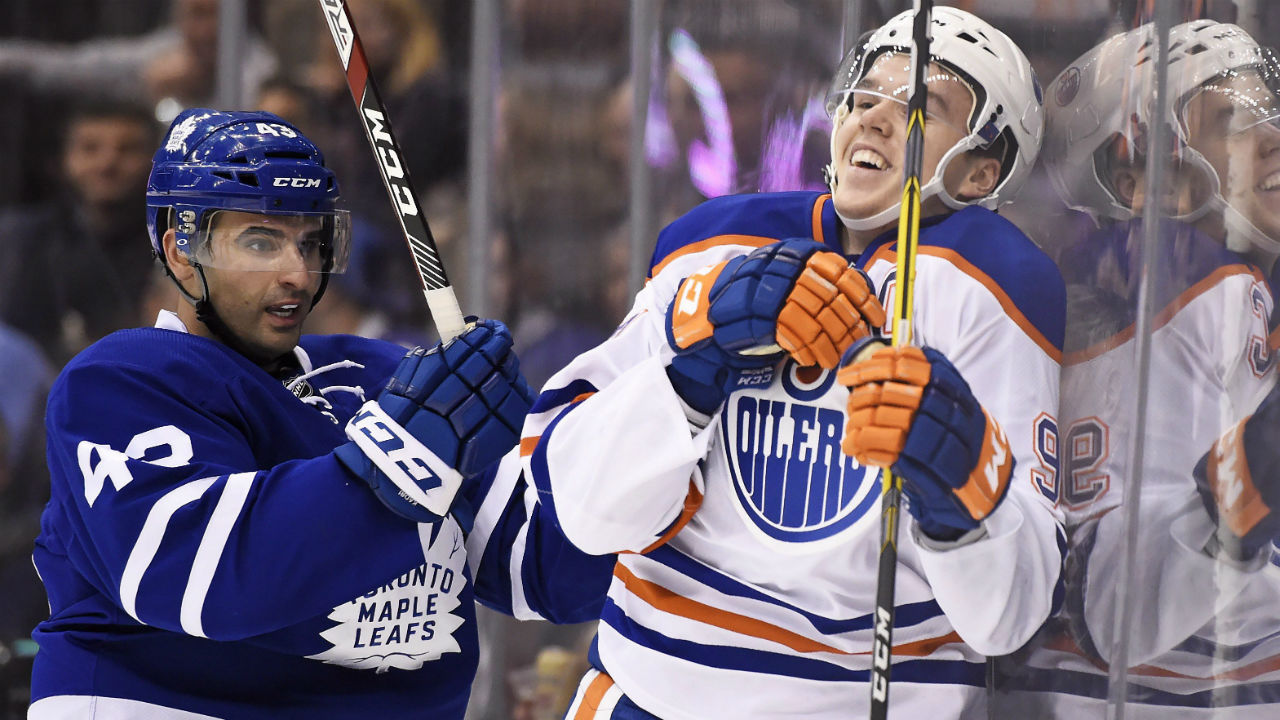A top-ten draft selection in the earliest stage of Toronto’s long rebuilding process, Nazem Kadri is the last Toronto Maple Leaf standing after four head coaching changes and three General Managers hires since 2009.
The London native and proud Maple Leaf has produced solid numbers on some miserable Toronto teams over the last five years. Fairly or unfairly, the lack of team success in an unforgiving hockey market also accentuated some of the growing pains early in Kadri’s career.
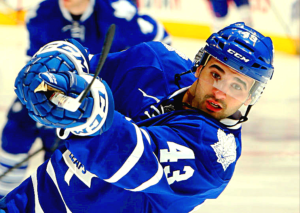
After struggling to win the favour of head coach Ron Wilson as a 20 and 21-year-old, Kadri was called out by Dallas Eakins in September of 2012 for showing up to Marlies camp out of shape (he later tore it up to the tune of 44 points in 48 NHL games when the lockout lifted). He survived the 18-wheeler freefall of 2011-12, as well as the changes following the epic collapses in the playoffs of 2013 and the return of the 18-wheeler down the stretch of the 2013-14 season. Amid the circus that was the 2014-15 Leaf season, Kadri slept in and turned up late to a team meeting held by Peter Horachek during his interim head coaching stint to end the year. He was subsequently suspended and called out publicly by Leafs President, and highly-respected Hall-of-Famer, Brendan Shanahan.
It wasn’t clear then just how well Kadri and Mike Babcock would get along upon Babcock’s arrival. The Leafs new head coach realized early in his first season that Tyler Bozak did not have the chops to suit his need for a shutdown center and thrust Kadri into the role early in the 2015-16 season. Fast forward to April and the growth Kadri had shown on and off the ice satisfied Shanahan, Babcock, Lamoriello and company to the point where they signed on the dotted line of a new six-year contract extension.
I think the biggest thing that Nazem proved is that he could play for Mike Babcock. I think he’s got a big fan in Mike Babcock. He’s an extremely competitive person. He shows a willingness to play at both ends of the ice. It’s important for him now to keep developing. He is now on a team where he is not the young guy anymore. He’s expected to be a presence and a veteran. I think that he likes that and I think he wants to embrace that.
– Brendan Shanahan, February 3rd, 2016
In the six months since, Kadri has seen Auston Matthews, William Nylander and Mitch Marner arrive in town and receive the majority of plaudits and attention from Toronto fans and media. Referring to the kids, Babcock — understandably — stated a few weeks ago that the fans now have a few players whose sweaters are worth buying.
That had to be a little tough to hear for the team’s number-one center from the season prior. Kadri is not the point-a-game franchise center Auston Matthews is going to become, nor will he continue to fill the same role once Matthews learns the league (he is already the target of shutdown efforts on the road without last change). But, as Kadri reminded us the other night against Edmonton, it’s not Matthews who currently occupies the most important role at center ice for the Leafs.
Kadri’s Percentages Are Rebounding
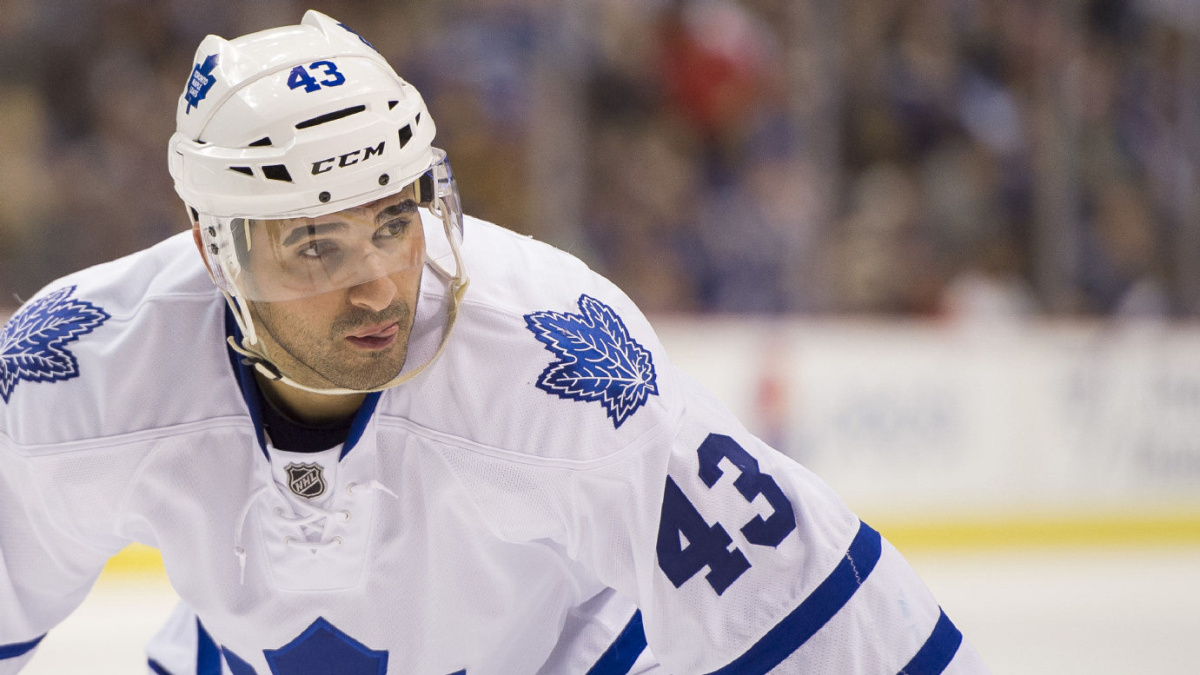
While Kadri committed himself to the defensive side of the game under the tutelage of Babcock, his offensive output, as was well documented, suffered in 2015-16. Before a breakthrough game in St. Louis on December 5th of 2015 — a big night for Kadri that included two goals, three points, and a fight against David Backes — Kadri was suffering through a barren first 25 games of the schedule; he had just three goals and nine points despite putting 94 shots on net. He stood seventh in the league in shots on goal and 222nd in points (3.2% shooting percentage). Among forwards league-wide, only Jakub Voracek was unluckier than Kadri to start the season (Voracek scored one goal on 75 shots in the opening 25 games).
Kadri’s attitude at the time was the right one — he cited the need for patience in his post-game scrums and continued to keep his shots rate high. While Kadri was never known for owning the most powerful shot in the league, at times it started to appear as though he had some kind of fatal flaw in his approach — he was directing such high shot volumes toward the net and many weren’t causing any issues for NHL goaltenders.
It has to get a lot better, how’s that?
– Mike Babcock on Nazem Kadri’s shot, November 2, 2016
Kadri’s percentages never fully rebounded en route to a 17-goal, 45-point 2014-15 season. He wasn’t in the clear after the awful start: March brought an 11-game goalless streak during which he scored zero goals on 33 shots. But, as Leafs fans were looking ahead to the Auston Matthews lottery and actively cheering for losses in the final few weeks of the season, Kadri was enjoying his best run of goal-scoring fortune of the 2015-16 campaign. A hat trick against Florida and a two-goal, four-point performance against Anaheim gave Kadri five goals and eight points in his final six games of the season prior to a season-ending suspension for a cross-check on Luke Glendening. Throughout the season, Kadri was working on his shot and striving to improve the deceptiveness of his release. Whether it was the fruits of his labour in practice, simply a turnaround of fortune, or both, he scored on 26% of his shots over those final six games.
The correction in luck seems to have carried over to the start of 2016-17. Kadri has scored five goals in 10 games while shooting 23.8% through ten games. Combined with his final six games to last season, Kadri has ten goals in his last 16 games and has scored on a quarter of his 40 shots over those 16 games. This kind of production will not last forever — particularly if he continues to shoot 2.1 times per game on average, as he has so far in 2016-17 — but there’s no disputing it’s well earned and long overdue.
Revisiting The Contract
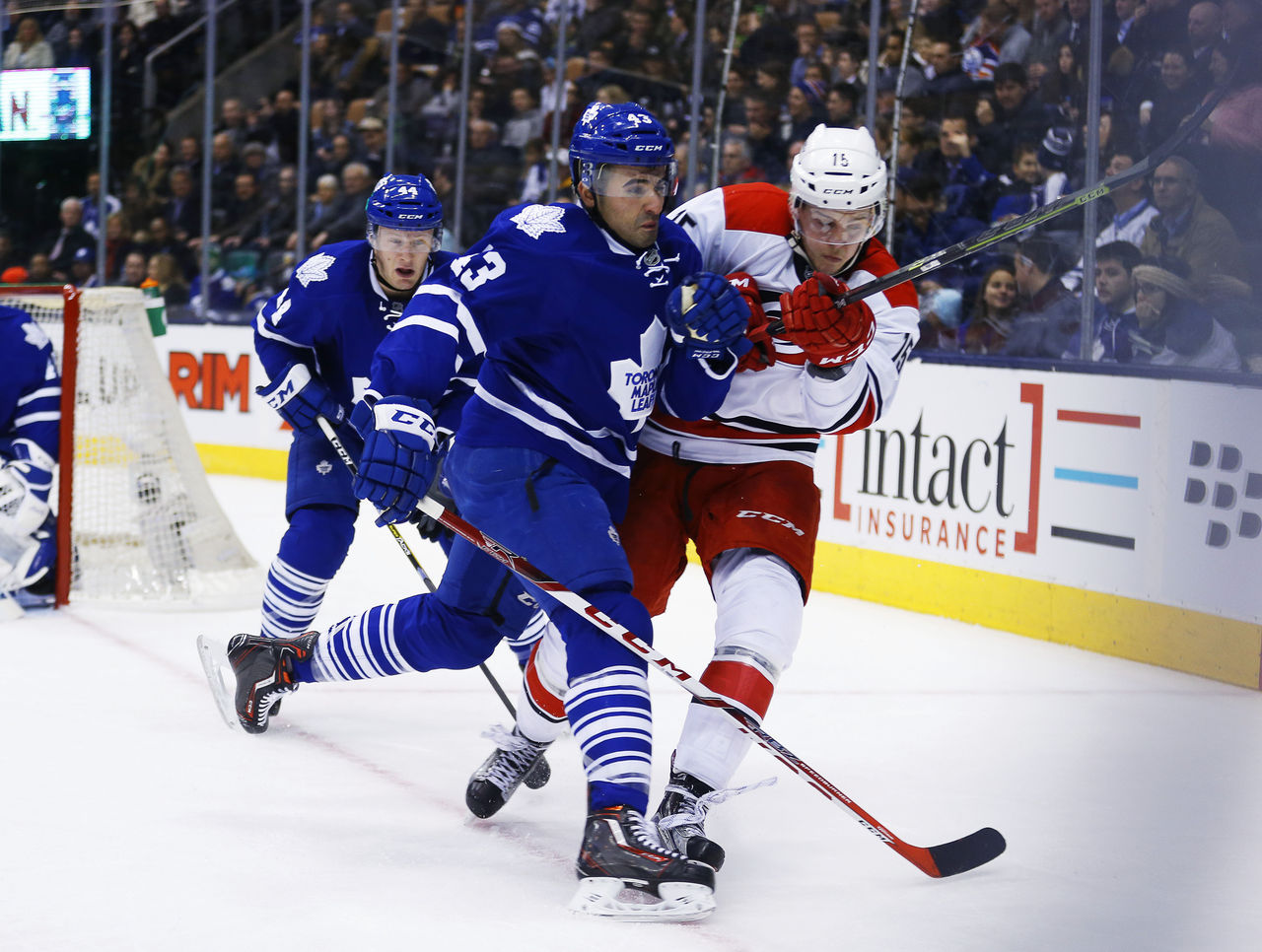
While he ended his 2015-16 season on an individual high note offensively, Kadri didn’t enter his third round of contract negotiations with a tonne of leverage given his recent production. With a history of drawn-out contract negotiations between Kadri’s party and Leafs management — the negotiation following the lockout year extended into September and turned ugly in the media (remember “false bobo“?) — there was some reason to believe there might be a tough negotiation ahead for the two sides. It was something of a surprise, then, when the Leafs announced a six-year deal worth $4.5 million a season just four days after the end of the 2015-16 season.
It came as a surprise partially due to Lou Lamoriello’s ‘cone of silence’ that had by now surrounded the Leafs organization, with every major move generating little-to-no advanced notice (there was no mention of active contract negotiations in the media, as is Lou’s policy). But it also signified a different approach. Despite full team control, the Leafs didn’t nickel and dime the pending RFA center who had just posted his lowest goals total since he broke the NHL full time. Babcock and Lamoriello and company were pleased with the progress they witnessed from Kadri — embracing his new on-ice role and maturing as a person off the ice — and moved quickly to reward him with a long-term deal. Loyalty, in this case, proved to be a two-way street.
In his first year as head coach, Babcock asked Kadri to play an unforgiving role that involved some self-sacrifice for the good of the team — in a contract year to boot. Playing shutdown minutes next to Leo Komarov and Michael Grabner aren’t the sort of conditions that beget a major offseason payday, to put it mildly. For a player who had always been a go-to offensive player in junior, in the AHL and even earlier in his NHL career in Toronto — and who had publicly indicated that he was betting on himself after accepting a one-year contract the previous summer — that likely wasn’t an easy role to accept for Kadri. Partly a credit to Babcock but mostly a credit to the player, Kadri embraced it fully.
Playing the toughest minutes on a tank team is a brutal role to say the least, and it wasn’t without bumps in the road, but Kadri showed signs of growth in the role last season. He had some memorable nights up against Anze Kopitar and David Backes in particular. He managed a +1.9 CF% relative to his teammates while playing the toughest role of any Leaf forward.
When you play head-to-head against the other [team’s] best players, when they getting running around the other night in L.A. and you’re running right back, and you’re greasy, I really like it.
– Mike Babcock on Nazem Kadri, January 14, 2016
Head to Head Matchups by the Numbers
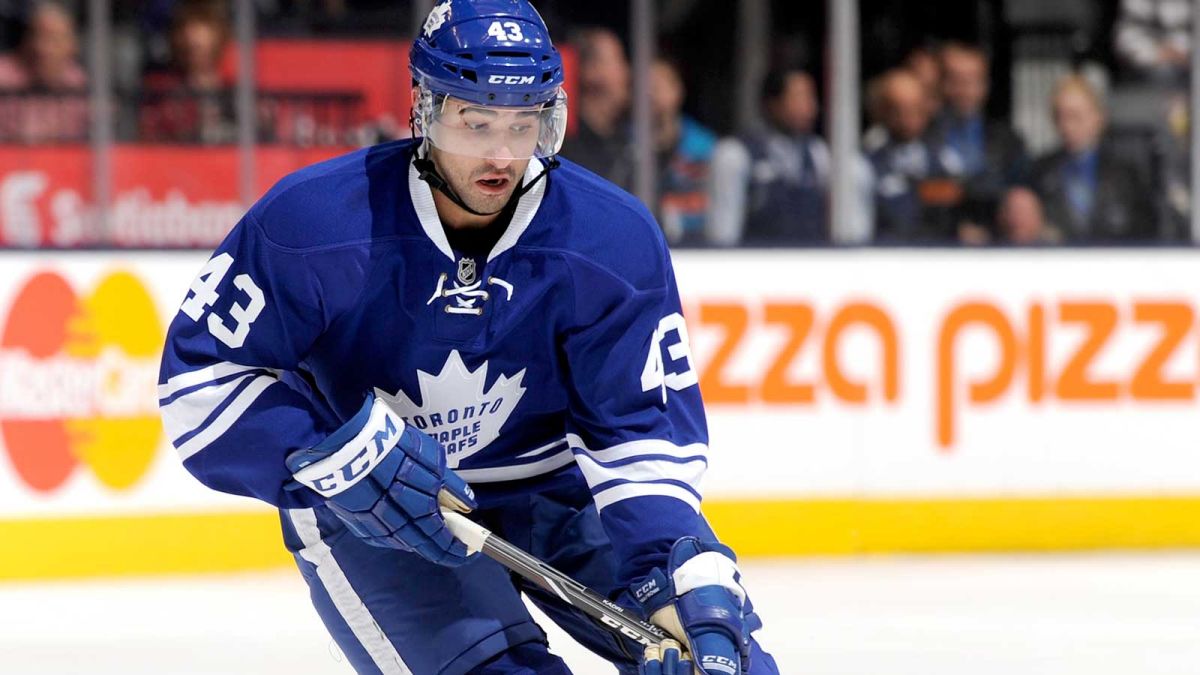
Kadri is the fulcrum down the middle for Toronto this season. The expectation is that he will take on all the tough head-to-head assignments — thereby creating an easier NHL transition for the Nylanders, Matthews and Marners of the roster — and produce like a top-six center in the process. That’s no mean feat, especially when the Leafs’ go-to defence pairing remains a work in progress.
Let’s take a look at how he’s performed in the role so far this season.
Nazem Kadri versus other top centers - 10 games
| Game | Opponent | Home/Away | Primary C Matchup | H2H 5v5 Mins | GF | GA | GF% H2H | CF | CA | CF% H2H |
|---|---|---|---|---|---|---|---|---|---|---|
| 1 | Ottawa | Away | Kyle Turris | 4:40 | 0 | 1 | 0% | 8 | 3 | 72.73% |
| 2 | Boston | Home | David Backes | 8:00 | 1 | 0 | 100% | 14 | 7 | 66.67% |
| 3 | Winnipeg | Away | Mark Scheifele | 4:25 | 0 | 1 | 0% | 3 | 6 | 33.33% |
| 4 | Minnesota | Away | Mikko Koivu | 10:55 | 0 | 0 | - | 11 | 10 | 52.38% |
| 5 | Chicago | Away | Jonathan Toews | 5:19 | 0 | 1 | 0% | 2 | 8 | 20% |
| 6 | Tampa Bay | Home | Tyler Johnson | 6:28 | 0 | 0 | - | 6 | 5 | 54.55% |
| 7 | Florida | Home | Aleksander Barkov | 11:07 | 0 | 0 | - | 11 | 13 | 45.83% |
| 8 | Montreal | Away | David Desharnais | 3:33 | 0 | 0 | - | 5 | 6 | 45.45% |
| 9 | NYI | Away | John Tavares | 7:39 | 0 | 0 | - | 9 | 10 | 47.37% |
| 10 | Edmonton | Home | Connor McDavid | 10:55 | 1 | 0 | 100% | 11 | 7 | 61.10% |
| 2 | 3 | 40% | 80 | 75 | 52% |
Obviously, these numbers only tell part of the story. It’s a ten-game sample size and context is needed. Kadri’s line handily carried the play against the HST (Hoffman, Stone, Turris) line in Ottawa, as shown in the shot attempts, but Turris scored off of a turnover caused by Milan Michalek (Kadri was in the right support position on the breakout play prior to the goal). The win against Florida, wherein Aleksander Barkov was a nonfactor and generated just one shot on goal, was a good night at the office for Kadri, even though he came out a few shot attempts in the negative. Against Tampa Bay, Kadri didn’t have a particularly effective game, facing limited time against Steve Stamkos as the game got away from the Leafs and Babcock strayed from his matchups.
Nevertheless, outside of two off-nights in Winnipeg and Chicago (inevitably, it’s going to go sideways some games against top competition), the results through ten games are encouraging. In the early going, Kadri is keeping top centers off the board with some consistency at even strength — despite a slow start by the Leafs goalies — and he has been carrying an edge in possession in his primary matchups while chipping in four even-strength points and four powerplay points in ten games.
A Unique Package
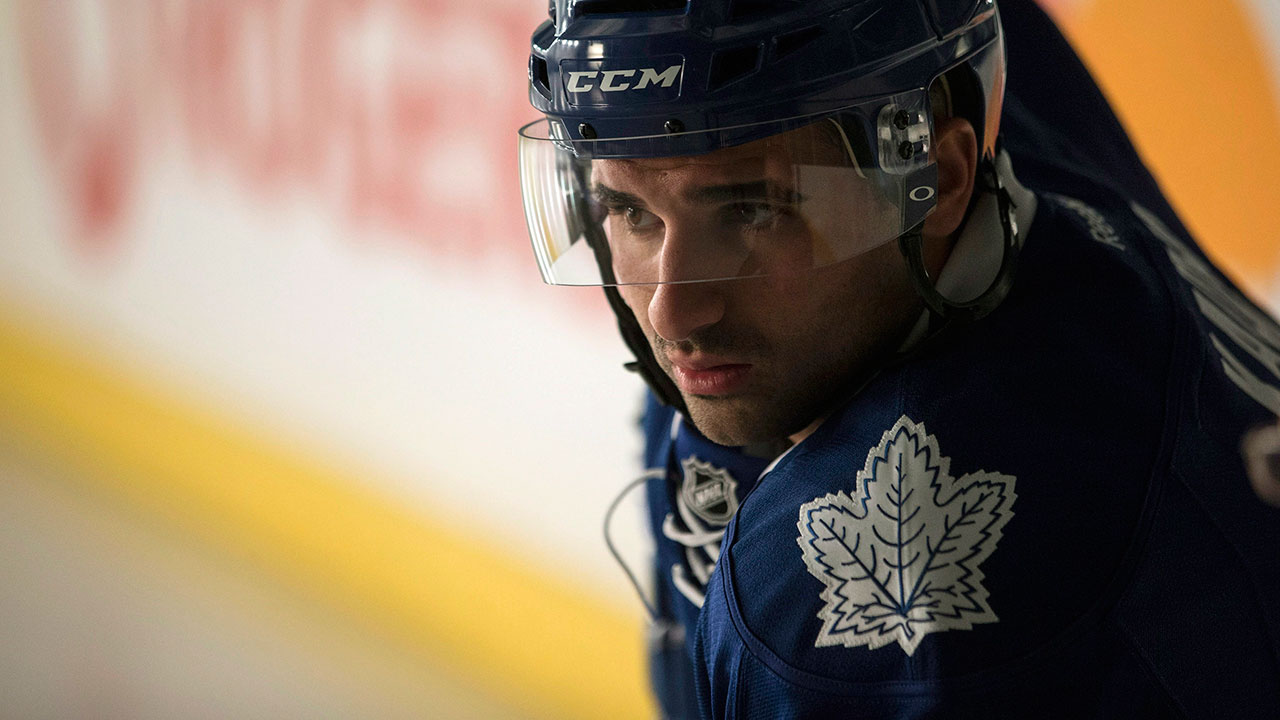
In addition to his boxcar production, improving 200-foot game and well-known play-driving abilities, there are some added bonuses to Kadri’s game that are worth mentioning/reiterating.
- He stays healthy: He’s never played less than 73 NHL games in a full season and he’s only missed 19 games of the Leafs’ last 304, 14 of which were due to suspension either by the team or the league. Staying healthy is a legitimate skill, and it’s one that Kadri seems to possess despite an average frame and a willingness to engage in the physical parts of the game.
I - He draws penalties: As has been well documented, he’s always been adept at keeping his feet moving in trafficked areas, evading checks, and — frankly — knowing when to let himself go down (it’s easy to hate, but it’s a skill that can provide a competitive edge in many sports). Since 2012-13, Kadri’s penalty differential is +92 (eighth in the NHL). It’s true that reputation calls are starting to turn against him following the diving fine from the league last season. There was one such call as recently as the game against Edmonton — he was clearly struck in the nether regions by a wayward stick, yet he was hauled off for embellishment — and there was another against Calgary late last season where he was mauled by a mob of Flames players and assessed an off-setting unsportsmanlike call. Kadri will have to walk this tightrope for the rest of his career. It’s part of the territory…
I - He’s a pest: As the Don Cherry’s and Brian Burke’s of the hockey world rue on a semi-regular basis, the NHL has moved on from pure fighters and gone the way of the agitator. On the broadcast during the Leafs-Oilers game on Tuesday, several times Ray Ferraro mentioned the amount of chatter Kadri was generating on the Oilers bench. He drew the attention of Milan Lucic when he shoved McDavid after the whistle in the first period. After the game, Morgan Rielly endearingly called him “a bit of a rat.” To Kadri’s credit, he’s been willing to back it up when push comes to fist — he has fought Victor Hedman and David Backes, among others, in recent seasons, both of whom he gives up four or five inches and 20 or 30 pounds to. A player who can bring those elements — especially if he draws more penalties than he takes, as Kadri does in spades — while contributing on the scoreboard has become something of a must-have for any team that wants to consider itself tough to play against in the modern era.
I’m almost shocked how good he’s been. And competitive, and greasy.
– Mike Babcock on Nazem Kadri





















